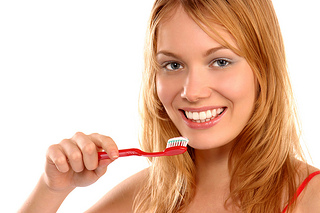July 26th, 2013

Looking back at childhood photos, you may notice picture after picture of yourself with a mouthful of shiny white teeth. When you look in the mirror today, you wonder what happened to that beautiful smile. Many adults struggle with tooth discoloration and find it embarrassing to show off their teeth in a smile. Once you identify the cause of your tooth discoloration, there are treatment options at Wortzel Integrative Dental Care that can restore your teeth and your confidence.
What Causes Tooth Discoloration?
There are a host of factors that may cause your teeth to discolor. Some are directly under your control, and others may not be preventable. Here is a list of common reasons that teeth become discolored.
- Genetics: Much of your dental health is determined by genetic factors beyond your control. Some people naturally have thinner enamel or discolored teeth.
- Medications: Several medications lead to tooth discoloration as a side effect. If you received the common antibiotics doxycycline or tetracycline as a child, your teeth may have discolored as a consequence. Antihistamines, high blood pressure medications, and antipsychotic drugs can also discolor teeth. If you think a medication may be leading to tooth discoloration, talk to Dr. Robert Wortzel. Never discontinue the use of a medication without consulting your doctor, however.
- Medical Conditions: Genetic conditions such as amelogenesis or dentinogenesis cause improper development of the enamel, and can lead to yellowed, discolored teeth.
- Poor Dental Hygiene: Failing to brush your teeth at least twice a day or regularly floss may lead to tooth decay and discoloration.
- Foods and Tobacco: Consumption of certain foods, including coffee, tea, wine, soda, apples, or potatoes, can cause tooth discoloration. Tobacco use also causes teeth to turn yellow or brown.
Treatments for Tooth Discoloration
There are a variety of treatments available to individuals with discolored teeth. One of the easiest ways to reduce tooth discoloration is through prevention. Avoid drinking red wine, soda, or coffee and stop using tobacco products. If you drink beverages that tend to leave stains, brush your teeth immediately or swish with water to reduce staining.
After determining the cause of tooth discoloration, Dr. Robert Wortzel can suggest other treatment options. Over-the-counter whitening agents might help, but in-office whitening treatments provided at our Mountainside, NJ office would be more effective. When whitening agents do not help, bondings or veneers are among the alternative solutions for tooth discoloration.
If you are worried about your teeth becoming yellow or brown, think carefully about your diet and medication use. Talk to Dr. Robert Wortzel to identify substances that may be causing the problem. After treatment for tooth discoloration, you will have a beautiful white smile you can be proud to show off.
July 19th, 2013

When a child is born, he or she will have 20 primary teeth and 32 permanent teeth. But sometimes kids are born with additional teeth, and our team at Wortzel Integrative Dental Care call this oral condition "hyperdontia." Primary teeth are the first set of teeth that erupt in your child's mouth, typically by the time they are 36 months old, and are shed by the time your child reaches the age of 12. Permanent teeth then take the place of the primary teeth and are usually fully-erupted by the time your son or daughter reaches 21 years of age. Anyone who develops more than 20 primary teeth or more than 32 permanent teeth has hyperdontia, and the additional teeth are referred to as supernumerary teeth.
While the cause of hyperdontia is not entirely clear, it is believed that there may be a genetic factor. Oral professionals have found that patients with extra teeth often have syndromes like cleidocranial dysplasia, Ehler-Danlos syndrome, Gardner syndrome, or cleft lip and palate. The prevalence of hyperdontia affects between one and four percent of the population in the United States, and the majority of cases are limited to a single tooth.
So, what is the best way to deal with hyperdontia? It really depends on the case. The treatment plan your doctor suggests varies according to the potential problem posed by the supernumerary teeth, as well as their type. Orthodontic treatment may certainly may help, but extraction can also be a good option. We recommend that children receive an oral evaluation or checkup no later than the age of seven. In addition to hygiene evaluation, this helps ensure your child does not experience hyperdontia problems.
If you suspect you or your child may be suffering from hyperdontia, please give us a call to schedule an appointment at our convenient Mountainside, NJ office to be evaluated.
July 16th, 2013

From the kitchens of Dr. Wortzel and his team at Integrative Dental Care, here is a yummy treat to get you going this summer!
Pumpkin Oatmeal Muffins
- 1/4 tsp of each cloves, nutmeg and ginger
- 1tsp baking powder
- ½ tsp each salt and baking soda
- 1C canned pumpkin
- 6oz (3/4 C) plain soy yogurt
- 2 TBS oil
- 2TBS ground flax seeds
- 6 TBS water
Preheat oven 375 degrees. Spray a 12 cup muffin tin with cooking spray, set aside. In a food processor, place the oats in, and process until fine and flour-like. Transfer to a large bowl. Add the flour, sugar, spices, baking powder, baking soda and salt. Stir with a whisk. In a separate bowl, whisk together the pumpkin,yogurt and oil. In the food processor add the flax seeds and water, process about 1 minute until slightly foamy. Add to the pumpkin mixture and whisk well. Add the pumpkin mixture to the dry ingredients and stir just until moistened and incorporated (batter will be thick, do not over mix). Spoon batter into the muffin cups. Bake for 20 minutes or until a wooden toothpick comes out clean. Cool in the pan for 5 minutes, then remove from the pan and cool completely on a wire rack.

Dentistry is a true marriage of art and science. Because of this, I’ve developed a unique approach to dentistry which not only focuses on the health of my patients’ teeth and gums, but also integrates each individual’s smile aesthetics.
Twitter, | Google+ | Facebook | YouTube
July 12th, 2013

Cheese, as our team at Wortzel Integrative Dental Care will tell you, is one of the healthiest snacks for your child’s teeth. In addition to providing large amounts of much-needed calcium, cheese also helps fight cavities. Cheese helps stimulate the body’s salivary glands to clear your child's mouth of debris and protect them from acids that weaken them. This means cheese disrupts the development of cavities, especially when eaten as a snack or at the end of a meal. Calcium and phosphorous found in cheese reduce or prevent decreases in the plaque’s pH level and work to re-mineralize the enamel of your child’s teeth, according to the American Academy of Pediatric Dentistry.
We hope this helps! If you or your child have any questions about cheese or calcium, or want to schedule an appointment, please give us a call!

Dentistry is a true marriage of art and science. Because of this, I’ve developed a unique approach to dentistry which not only focuses on the health of my patients’ teeth and gums, but also integrates each individual’s smile aesthetics.
Twitter, | Google+ | Facebook | YouTube





